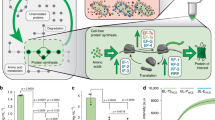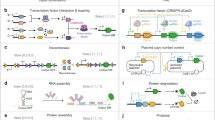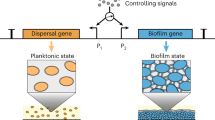Abstract
The synthesis of increasingly complex unnatural networks embedded in living matter is an emerging theme in synthetic biology. Synthetic networks have allowed the creation of organisms endowed with toggle switches, logic gates, pattern-forming systems, oscillators, cellular sensors, new modes of gene regulation and expanded genetic codes. A common challenge of this work is the addition of specific new functions to complex living organisms. This requires spatial and temporal control of molecular interactions and fluxes to achieve the desired outcomes. Here we review recent successes in this emerging field and discuss strategies for addressing the challenges of increasing network complexity.
This is a preview of subscription content, access via your institution
Access options
Subscribe to this journal
Receive 12 print issues and online access
$259.00 per year
only $21.58 per issue
Buy this article
- Purchase on Springer Link
- Instant access to full article PDF
Prices may be subject to local taxes which are calculated during checkout






Similar content being viewed by others
References
Hartwell, L.H., Hopfield, J.J., Leibler, S. & Murray, A.W. From molecular to modular cell biology. Nature 402, C47–C52 (1999).
Kashtan, N. & Alon, U. Spontaneous evolution of modularity and network motifs. Proc. Natl. Acad. Sci. USA 102, 13773–13778 (2005).
Gardner, T.S., Cantor, C.R. & Collins, J.J. Construction of a genetic toggle switch in Escherichia coli . Nature 403, 339–342 (2000).
Kobayashi, H. et al. Programmable cells: interfacing natural and engineered gene networks. Proc. Natl. Acad. Sci. USA 101, 8414–8419 (2004).
Kramer, B.P. et al. An engineered epigenetic transgene switch in mammalian cells. Nat. Biotechnol. 22, 867–870 (2004).
Elowitz, M.B. & Leibler, S. A synthetic oscillatory network of transcriptional regulators. Nature 403, 335–338 (2000).
Atkinson, M.R., Savageau, M.A., Myers, J.T. & Ninfa, A.J. Development of genetic circuitry exhibiting toggle switch or oscillatory behavior in Escherichia coli . Cell 113, 597–607 (2003).
Fung, E. et al. A synthetic gene-metabolic oscillator. Nature 435, 118–122 (2005).
Kaern, M., Blake, W.J. & Collins, J.J. The engineering of gene regulatory networks. Annu. Rev. Biomed. Eng. 5, 179–206 (2003).
Becskei, A. & Serrano, L. Engineering stability in gene networks by autoregulation. Nature 405, 590–593 (2000).
Elowitz, M.B., Levine, A.J., Siggia, E.D. & Swain, P.S. Stochastic gene expression in a single cell. Science 297, 1183–1186 (2002).
Swain, P.S., Elowitz, M.B. & Siggia, E.D. Intrinsic and extrinsic contributions to stochasticity in gene expression. Proc. Natl. Acad. Sci. USA 99, 12795–12800 (2002).
Rosenfeld, N., Young, J.W., Alon, U., Swain, P.S. & Elowitz, M.B. Gene regulation at the single-cell level. Science 307, 1962–1965 (2005).
Pedraza, J.M. & van Oudenaarden, A. Noise propagation in gene networks. Science 307, 1965–1969 (2005).
Ozbudak, E.M., Thattai, M., Kurtser, I., Grossman, A.D. & van Oudenaarden, A. Regulation of noise in the expression of a single gene. Nat. Genet. 31, 69–73 (2002).
Isaacs, F.J., Hasty, J., Cantor, C.R. & Collins, J.J. Prediction and measurement of an autoregulatory genetic module. Proc. Natl. Acad. Sci. USA 100, 7714–7719 (2003).
Blake, W.J., Kaern, M., Cantor, C.R. & Collins, J.J. Noise in eukaryotic gene expression. Nature 422, 633–637 (2003).
Raser, J.M. & O'Shea, E.K. Control of stochasticity in eukaryotic gene expression. Science 304, 1811–1814 (2004).
Rao, C.V., Wolf, D.M. & Arkin, A.P. Control, exploitation and tolerance of intracellular noise. Nature 420, 231–237 (2002).
Cai, L., Friedman, N. & Xie, X.S. Stochastic protein expression in individual cells at the single molecule level. Nature 440, 358–362 (2006).
Suel, G.M., Garcia-Ojalvo, J., Liberman, L.M. & Elowitz, M.B. An excitable gene regulatory circuit induces transient cellular differentiation. Nature 440, 545–550 (2006).
Guet, C.C., Elowitz, M.B., Hsing, W. & Leibler, S. Combinatorial synthesis of genetic networks. Science 296, 1466–1470 (2002).
You, L., Cox, R.S., III, Weiss, R. & Arnold, F.H. Programmed population control by cell-cell communication and regulated killing. Nature 428, 868–871 (2004).
Anderson, J.C., Clarke, E.J., Arkin, A.P. & Voigt, C.A. Environmentally controlled invasion of cancer cells by engineered bacteria. J. Mol. Biol. 355, 619–627 (2006).
Basu, S., Gerchman, Y., Collins, C.H., Arnold, F.H. & Weiss, R. A synthetic multicellular system for programmed pattern formation. Nature 434, 1130–1134 (2005).
Basu, S., Mehreja, R., Thiberge, S., Chen, M.T. & Weiss, R. Spatiotemporal control of gene expression with pulse-generating networks. Proc. Natl. Acad. Sci. USA 101, 6355–6360 (2004).
Chen, M.T. & Weiss, R. Artificial cell-cell communication in yeast Saccharomyces cerevisiae using signaling elements from Arabidopsis thaliana . Nat. Biotechnol. 23, 1551–1555 (2005).
Bulter, T. et al. Design of artificial cell-cell communication using gene and metabolic networks. Proc. Natl. Acad. Sci. USA 101, 2299–2304 (2004).
Levskaya, A. et al. Synthetic biology: engineering Escherichia coli to see light. Nature 438, 441–442 (2005).
Derr, P., Boder, E. & Goulian, M. Changing the specificity of a bacterial chemoreceptor. J. Mol. Biol. 355, 923–932 (2006).
Looger, L.L., Dwyer, M.A., Smith, J.J. & Hellinga, H.W. Computational design of receptor and sensor proteins with novel functions. Nature 423, 185–190 (2003).
Desmet, J., Demaeyer, M., Hazes, B. & Lasters, I. The dead-end elimination theorem and its use in protein side-chain positioning. Nature 356, 539–542 (1992).
Park, S.H., Zarrinpar, A. & Lim, W.A. Rewiring MAP kinase pathways using alternative scaffold assembly mechanisms. Science 299, 1061–1064 (2003).
Bhattacharyya, R.P. et al. The Ste5 scaffold allosterically modulates signaling output of the yeast mating pathway. Science 311, 822–826 (2006).
Chin, J.W. et al. An expanded eukaryotic genetic code. Science 301, 964–967 (2003).
Wang, L., Brock, A., Herberich, B. & Schultz, P.G. Expanding the genetic code of Escherichia coli . Science 292, 498–500 (2001).
Chin, J.W., Cropp, T.A., Chu, S., Meggers, E. & Schultz, P.G. Progress toward an expanded eukaryotic genetic code. Chem. Biol. 10, 511–519 (2003).
Kwok, Y. & Wong, J.T. Evolutionary relationship between Halobacterium cutirubrum and eukaryotes determined by use of aminoacyl-tRNA synthetases as phylogenetic probes. Can. J. Biochem. 58, 213–218 (1980).
Santoro, S.W., Wang, L., Herberich, B., King, D.S. & Schultz, P.G. An efficient system for the evolution of aminoacyl-tRNA synthetase specificity. Nat. Biotechnol. 20, 1044–1048 (2002).
Chin, J.W., Martin, A.B., King, D.S., Wang, L. & Schultz, P.G. Addition of a photocrosslinking amino acid to the genetic code of Escherichia coli . Proc. Natl. Acad. Sci. USA 99, 11020–11024 (2002).
Cropp, T.A. & Schultz, P.G. An expanding genetic code. Trends Genet. 20, 625–630 (2004).
Sakamoto, K. et al. Site-specific incorporation of an unnatural amino acid into proteins in mammalian cells. Nucleic Acids Res. 30, 4692–4699 (2002).
Hino, N. et al. Protein photo-cross-linking in mammalian cells by site-specific incorporation of a photoreactive amino acid. Nat. Methods 2, 201–206 (2005).
Anderson, J.C. et al. An expanded genetic code with a functional quadruplet codon. Proc. Natl. Acad. Sci. USA 101, 7566–7571 (2004).
Mehl, R.A. et al. Generation of a bacterium with a 21 amino acid genetic code. J. Am. Chem. Soc. 125, 935–939 (2003).
Bayer, T.S. & Smolke, C.D. Programmable ligand-controlled riboregulators of eukaryotic gene expression. Nat. Biotechnol. 23, 337–343 (2005).
Isaacs, F.J. et al. Engineered riboregulators enable post-transcriptional control of gene expression. Nat. Biotechnol. 22, 841–847 (2004).
Rackham, O. & Chin, J.W. A network of orthogonal ribosome × mRNA pairs. Nat. Chem. Biol. 1, 159–166 (2005).
Rackham, O. & Chin, J.W. Cellular logic with orthogonal ribosomes. J. Am. Chem. Soc. 127, 17584–17585 (2005).
Rackham, O., Wang, K. & Chin, J.W. Functional epitopes at the ribosome subunit interface. Nat. Chem. Biol. 2, 254–258 (2006).
Tian, J. et al. Accurate multiplex gene synthesis from programmable DNA microchips. Nature 432, 1050–1054 (2004).
Cello, J., Paul, A.V. & Wimmer, E. Chemical synthesis of poliovirus cDNA: generation of infectious virus in the absence of natural template. Science 297, 1016–1018 (2002).
Smith, H.O., Hutchison, C.A., III, Pfannkoch, C. & Venter, J.C. Generating a synthetic genome by whole genome assembly: phiX174 bacteriophage from synthetic oligonucleotides. Proc. Natl. Acad. Sci. USA 100, 15440–15445 (2003).
Kodumal, S.J. et al. Total synthesis of long DNA sequences: synthesis of a contiguous 32-kb polyketide synthase gene cluster. Proc. Natl. Acad. Sci. USA 101, 15573–15578 (2004).
Stemmer, W.P., Crameri, A., Ha, K.D., Brennan, T.M. & Heyneker, H.L. Single-step assembly of a gene and entire plasmid from large numbers of oligodeoxyribonucleotides. Gene 164, 49–53 (1995).
Binkowski, B.F., Richmond, K.E., Kaysen, J., Sussman, M.R. & Belshaw, P.J. Correcting errors in synthetic DNA through consensus shuffling. Nucleic Acids Res. 33, e55 (2005).
Endy, D. Foundations for engineering biology. Nature 438, 449–453 (2005).
Yokobayashi, Y., Weiss, R. & Arnold, F.H. Directed evolution of a genetic circuit. Proc. Natl. Acad. Sci. USA 99, 16587–16591 (2002).
Farmer, W.R. & Liao, J.C. Improving lycopene production in Escherichia coli by engineering metabolic control. Nat. Biotechnol. 18, 533–537 (2000).
Mukherjee, K.J., Rowe, D.C., Watkins, N.A. & Summers, D.K. Studies of single-chain antibody expression in quiescent Escherichia coli . Appl. Environ. Microbiol. 70, 3005–3012 (2004).
Rowe, D.C. & Summers, D.K. The quiescent-cell expression system for protein synthesis in Escherichia coli . Appl. Environ. Microbiol. 65, 2710–2715 (1999).
Guido, N.J. et al. A bottom-up approach to gene regulation. Nature 439, 856–860 (2006).
Szostak, J.W., Bartel, D.P. & Luisi, P.L. Synthesizing life. Nature 409, 387–390 (2001).
Acknowledgements
I thank J.J. Collins, M.B. Elowitz, M. Kaern and R. Weiss for sharing figures, and T.A. Cropp, J.C. Anderson, P. Holliger and P. Lee for critical reading. J.W. Chin is an EMBO Young Investigator.
Author information
Authors and Affiliations
Corresponding author
Ethics declarations
Competing interests
The author declares no competing financial interests.
Rights and permissions
About this article
Cite this article
Chin, J. Modular approaches to expanding the functions of living matter. Nat Chem Biol 2, 304–311 (2006). https://doi.org/10.1038/nchembio789
Published:
Issue Date:
DOI: https://doi.org/10.1038/nchembio789
This article is cited by
-
Synthetic circuits that process multiple light and chemical signal inputs
BMC Systems Biology (2017)
-
Engineered biological nanofactories trigger quorum sensing response in targeted bacteria
Nature Nanotechnology (2010)
-
Scaling up synthetic gene circuits
Nature Nanotechnology (2010)
-
Emergent bistability by a growth-modulating positive feedback circuit
Nature Chemical Biology (2009)
-
A synthetic Escherichia coli predator–prey ecosystem
Molecular Systems Biology (2008)



